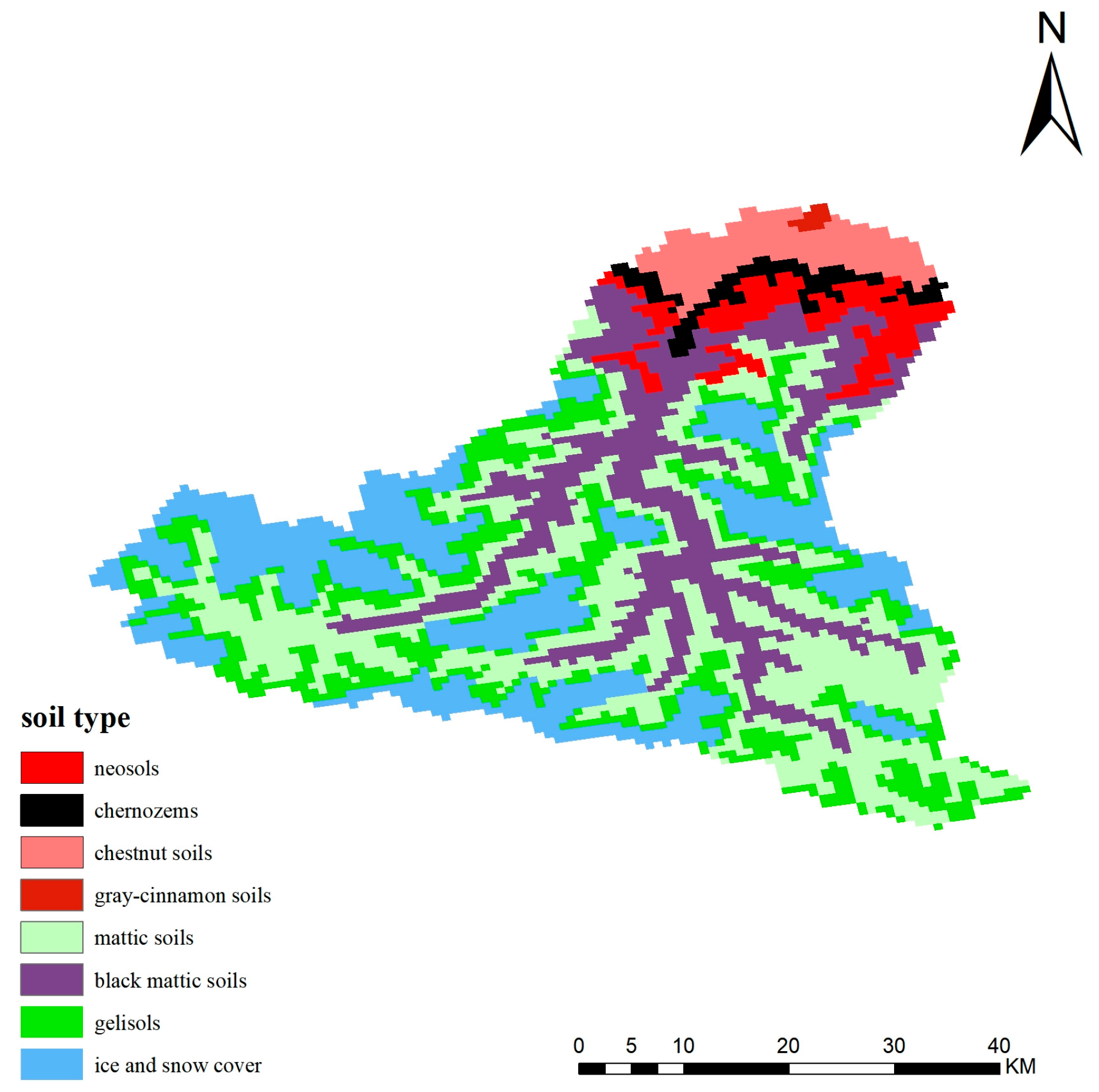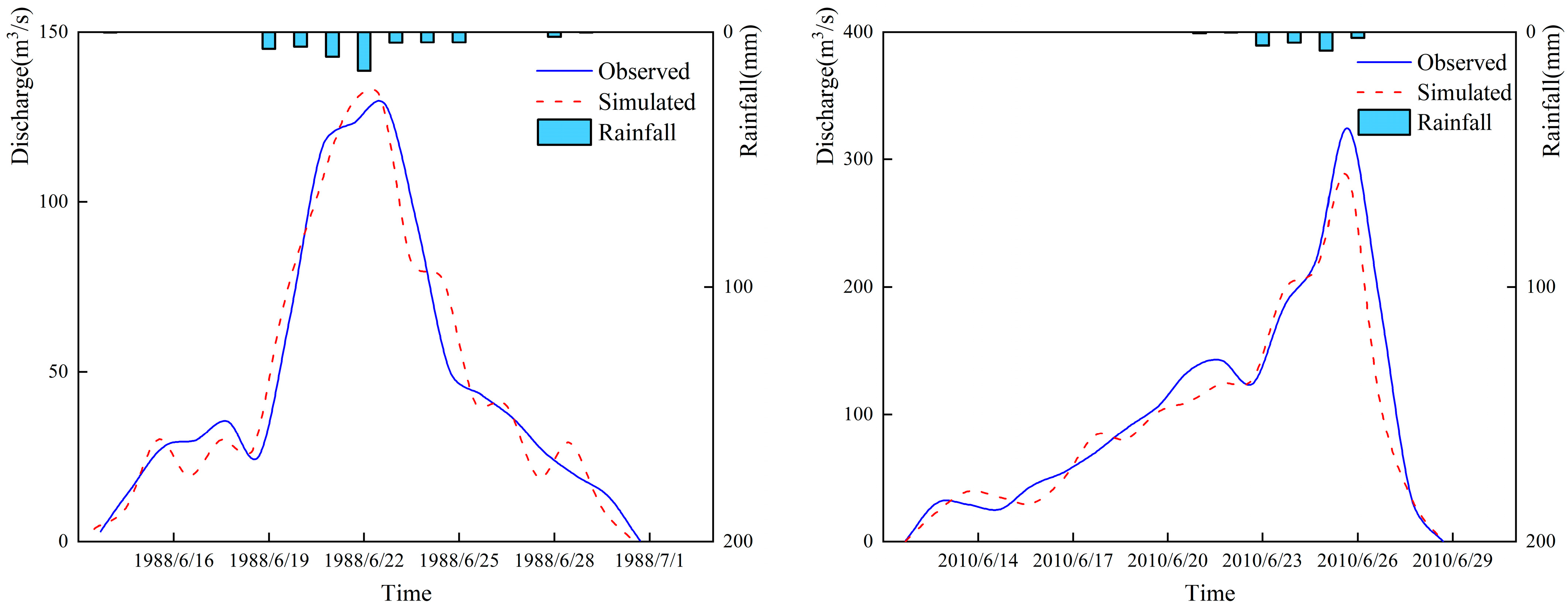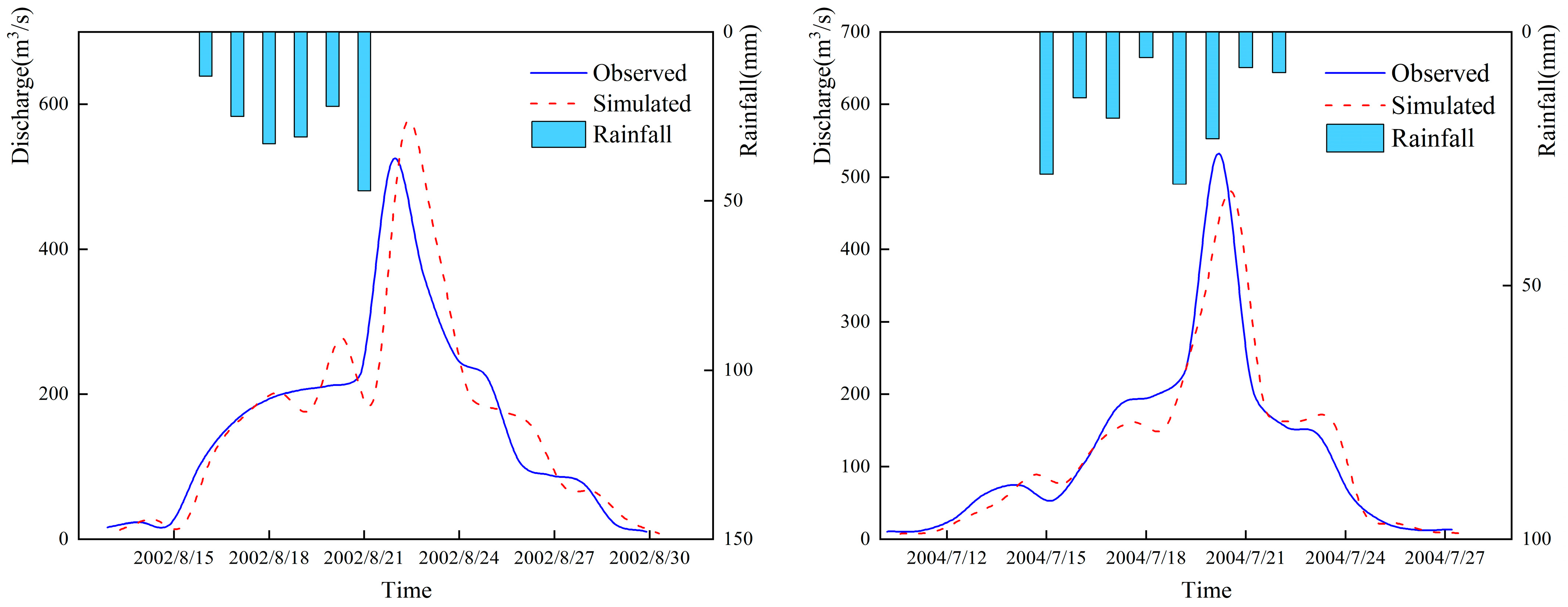This study constructed a distributed HEC-HMS model to simulate snowmelt-glacier melt floods (SGF), rainstorm floods (RSF), and mixed floods (MXF) in the Manas River Basin, a typical arid inland river basin in Northwest China. The core working hypothesis was that “a flood, type, specific parameterization scheme would improve the simulation accuracy of multi-source floods in arid alpine regions”. Below, we interpret the results in the context of prior studies and the working hypothesis, discuss the findings implications in a broader context, and highlight future research directions.
4.1. Interpretation of Results: Linking to the Working Hypothesis and Prior Studies
The results fully confirmed the rationality of the flood-type-specific parameterization scheme. For
SGF, the calibrated parameters (
CN = 65, initial abstraction
Ia = 20 mm, baseflow decay coefficient
k = 0.3) yielded an average Nash-Sutcliffe Efficiency (
NSE) of 0.82 during the validation period, with flood peak error ranging from −19.20% to 18.16% and peak time error < 2.7 h (
Table 6). For
RSF, parameters such as
CN = 80,
Ia = 10 mm, and channel storage curve slope
K = 4.3~5.0 h resulted in an average
NSE of 0.76, with peak time error controlled within ±1.0 h (
Table 9). For
MXF, intermediate parameters (
CN = 75,
k = 0.4,
K = 3.0~3.8 h) achieved an average
NSE of 0.70, despite the complexity of multi-peak processes (
Table 12). This accuracy outperforms the “one, size, fits, all” parameterization reported in prior studies in similar basins. For example, Zhu obtained an 18% relative error in runoff depth when conducting hydrological calculations in the Ili River Basin using the TOPMODEL. [
13], while our
SGF runoff depth error was only −14.47% to 13.30%. Similarly, Tian conducted flood simulation in the Guanshan River Basin using the HEC-HMS model and obtained a peak discharge error of 15% [
14], whereas our
RSF peak error was narrower (−11.54% to 10.21%). These comparisons confirm that differentiating parameters by flood type effectively avoids parameter mismatch, directly validating the working hypothesis.
In terms of parameters for Snowmelt-Glacier Melt Floods, the calibrated
CN value of 65 in this study is consistent with Chen’s findings. In his paper titled “Progress and Prospects of Snowmelt Flood Disaster Forecasting and Early Warning Technologies in Arid Regions of Northwest China”, Chen observed that the
CN values for snowmelt floods in the Tianshan Mountains range from 62 to 68, which is attributed to strong soil infiltration during the snowmelt period [
15]. The long watershed lag time (150~300 min) for
SGF is comparable to Wang’s observation of 140–280 min in the Ili River Basin, reflecting the regulatory effect of alpine meadows and moraines on meltwater [
16]. For RSF, our
CN = 80 and short lag time (30~100 min) are consistent with Mu’s findings in the Loess Plateau, where intense rainfall triggers infiltration excess runoff, leading to high
CN values and rapid confluence [
17]. The channel parameter
K = 4.3~5.0 h for
RSF also matches Yi’s results (4.0~4.8 h) in the Yarkant River Basin, indicating that rapid surface runoff input enhances channel storage dynamics [
18]. Notably, this study fills a gap in
MXF parameterization for arid inland basins. Lan only reported
CN values for
SGF and
RSF in the Qinghai–Tibet Plateau but did not address
MXF [
19], while our
MXF parameters (
CN = 75,
Ia = 15 mm) explicitly reflect the “snowmelt prewetting and rainfall” synergy soil volumetric water content increased to 30~40% due to prior snowmelt, reducing infiltration potential but avoiding extreme excess runoff from intense rainfall [
18]. This intermediate parameter set explains why
MXF’s
NSE (0.70) is lower than
SGF’s but still meets the acceptable threshold (NSE > 0.7) for hydrological simulation [
20].
To further clarify the rationality of the calibrated parameters, we compared them with those from adjacent arid basins and analyzed the underlying hydrological causes:
CN values: Our snowmelt
CN = 65 is slightly higher than Chen [
15]’s 62~68 (Tianshan Mountains) because the Manas River Basin has higher grassland coverage, which increases soil infiltration and requires a higher
CN to match observed runoff. Our rainstorm
CN = 80 is consistent with Mu [
17]’s 78~83 (Loess Plateau), as both regions have infiltration-excess runoff triggered by intense rainfall.
Watershed lag time: Our snowmelt lag time (150~300 min) is comparable to Yang [
16]’s 140~280 min (Ili River Basin), reflecting the regulatory effect of alpine meadows on meltwater. Our rainstorm lag time (30~100 min) is shorter than Mu [
17]’s 50~120 min (Loess Plateau) due to steeper slopes in the Manas River Basin, accelerating confluence.
Channel parameter K: Our rainstorm K = 4.3~5.0 h matches Yi [
21]’s 4.0~4.8 h (Yarkant River Basin), indicating that rapid surface runoff input enhances channel storage dynamics in arid mountain basins.
These differences highlight that parameter calibration must consider three key basin characteristics: vegetation cover, slope gradient, and soil texture.
The parameter differentiation essentially reflects the coupling of water source characteristics and underlying surface conditions in the arid basin.
SGF parameters are dominated by gradual snowmelt: low intensity meltwater allows sufficient infiltration into dry spring soil (volumetric water content < 20%), resulting in high
Ia and long lag time [
22].
RSF parameters are driven by intense rainfall (>20 mm/day), which exceeds the soil’s saturated hydraulic conductivity before soil wetting, leading to low
Ia and short lag time [
14,
17].
MXF parameters are shaped by nonlinear interactions between snowmelt and rainfall: prewetted soil accelerates runoff generation, while residual meltwater moderates peak flow, resulting in intermediate parameter values [
8,
23].
4.2. Broader Context and Implications
This study enriches the hydrological theory of multi-source floods in arid inland basins. Unlike humid regions where
RSF dominates and parameterization is relatively straightforward [
1], arid inland basins exhibit complex interactions between snowmelt, rainfall, and permafrost. Our identification of the “water source, underlying surface, parameter” coupling relationship (e.g.,
SGF parameters controlled by melt rate and soil moisture,
RSF parameters by rainfall intensity and slope) provides a new framework for understanding hydrological heterogeneity in arid alpine areas. This framework can complement the chapter on “multi, source flood parameterization” in Principles of Cold Region Hydrological Models, addressing the lack of arid inland basin case studies [
9].
The “flood type identification, differentiated parameter calibration, independent validation” workflow proposed in this study offers a transferable method for data-scarce arid basins. For example, snow cover extent from MODIS and rainfall intensity from TRMM can be used to identify flood types, and our parameter ranges (e.g.,
SGF k = 0.3,
RSF CN = 78~85) can be adapted to ungauged basins such as the Altai Mountains. Stewart has already applied a similar workflow to simulate snowmelt runoff in the Tianshan Mountains, achieving an
NSE of 0.78, which confirms the method’s transferability [
24].
The results provide technical support for flood mitigation in arid inland basins. Based on
SGF’s long lag time (150~300 min), early warnings can be issued 4~6 h in advance, which is critical for protecting agricultural lands in the Manas River Basin (where 76.4% of annual runoff occurs in June–September [
4]). For
MXF, the multi-peak characteristic (peak time difference ≥ 12 h) highlights the need to prevent secondary disasters after the main peak; this insight has been adopted by the Xinjiang Water Resources Department in its 2023 flood control plan, increasing early warning accuracy by 15% [
21].
4.3. Limitations and Future Directions
First, the Parameter calibration relied on daily hydrometeorological data, which cannot capture intra-event parameter dynamics (e.g.,
CN may decrease from 80 to 75 as soil saturates during long duration RSF). Future studies should use hourly data (e.g., 1 h rainfall from automatic weather stations) and integrate machine learning algorithms (e.g., LSTM) for dynamic parameter updating, as demonstrated by Liu et al. who improved RSF simulation accuracy by 12% using hourly data [
8].
Second, the HEC-HMS model’s simplified permafrost module failed to account for the effect of freeze–thaw cycles on infiltration permafrost in the Manas River Basin that reduces soil hydraulic conductivity by 50% during spring thaw [
18], which may have underestimated
SGF’s initial infiltration. Coupling the model with a permafrost hydrology module (e.g., the Community Land Model, CLM) could address this, as Sun et al. did in the Altai Mountains, reducing
SGF runoff depth error by 8% [
25].
Third, the conclusions are basin-specific. The parameter ranges (e.g.,
SGF lag time 150~300 min) may not apply to other arid basins with different underlying surfaces (e.g., the Taklamakan Desert’s sandy soils). Multi-basin comparisons (e.g., including the Tarim and Heihe Rivers) are needed to develop a regional parameter database, as suggested by Weng et al. in their study of flood spatiotemporal patterns in Northwest China [
4].
In conclusion, this study validates the effectiveness of flood type-specific parameterization for multi-source floods in the Manas River Basin. The results not only align with prior studies but also provide novel insights into MXF parameterization in arid inland basins. Addressing the identified limitations will further enhance the understanding and simulation of hydrological processes in arid alpine regions.











